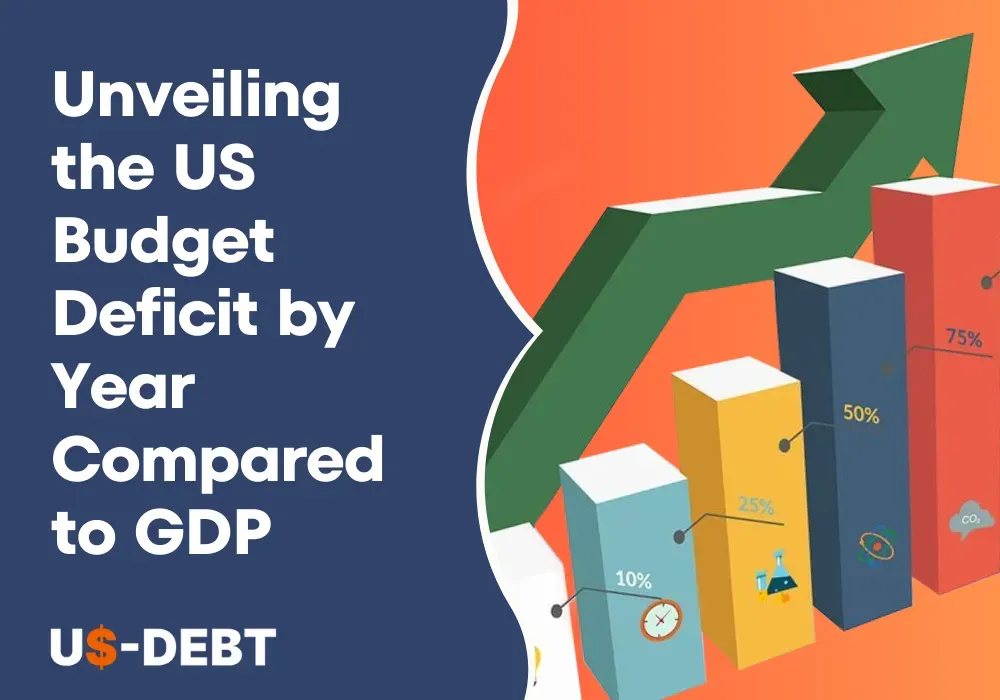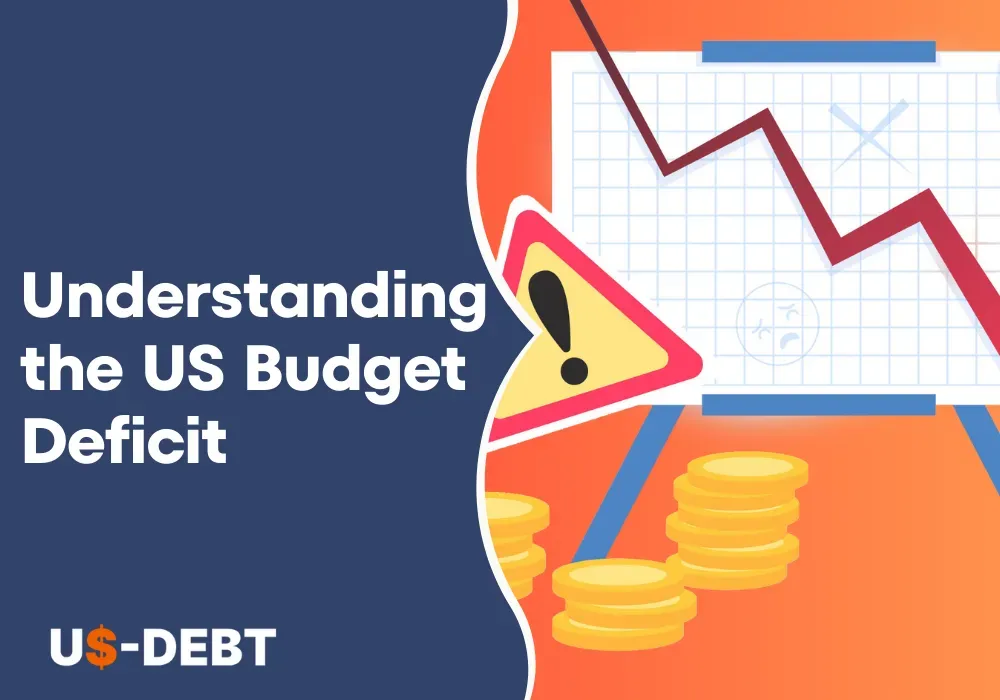The US budget deficit is a crucial economic metric that reveals the country's stability and financial health. In a particular fiscal year, it happens when the government has a shortfall as a result of spending exceeding receipts. In this blog, we will explore the relationship, causes, and implications of the US budget deficit by year compared to GDP, shedding light on its significance for the economy.
Â
Measurement of the US Budget Deficit
The calculation of the budget deficit involves comparing government expenditures with government revenues. If the expenditures exceed the revenue, it results in a budget deficit. Mathematically, the budget deficit can be represented as:
Budget Deficit = Total Expenditures - Total Revenue
The deficit may be further broken down into the primary deficit and the interest payments on the debt.
Â
Understanding GDP and Its Significance
The entire worth of products and services generated inside a nation's boundaries during a certain period is calculated as the gross domestic product or GDP. Considering GDP is crucial when understanding the budget deficit because it provides a relative perspective on the deficit's magnitude and impact on the economy.
We may assess the proportionate amount of the deficit concerning the country's entire economic activity by comparing the budget deficit to GDP. The ability of the nation to balance its budget and maintain its economic strength may be in peril if there is a considerable gap between government expense and national economic growth, as revealed by a considerable deficit as a proportion of GDP. Conversely, a smaller deficit relative to GDP suggests a more manageable fiscal situation.
Furthermore, GDP growth or contraction influences the deficit-GDP ratio. Tax collections often expand during times of economic growth, which lowers the deficit as a proportion of GDP. Conversely, economic downturns can lead to reduced tax revenues and increased government spending, potentially widening the deficit-GDP ratio.
Â
Historical Analysis: US Budget Deficit by Year
Studying the historical trends of the US budget deficit provides valuable insights into the nation's fiscal trajectory. Over the years, the US has experienced fluxes in the budget deficit, affected by economic conditions, government policies, and external factors. Understanding these trends helps identify patterns and potential factors contributing to deficit fluctuations.
Certain years in history have witnessed notable deficits that have had significant implications for the economy. For example, the US suffered a considerable elevation in the budget deficit during the Great Recession of 2008â2009 due to lower tax receipts and higher government expenditure on social safety nets and rehabilitation campaigns. Similarly, the early 1990s saw deficits driven by factors such as the Gulf War and economic downturn.
Comparing the deficit figures to GDP provides a meaningful perspective on the scale and impact of deficits concerning the overall economy. By calculating the deficit as a percentage of GDP, we can specify the deficit-GDP ratio, which reveals the deficit's relative size and consequence. A high deficit-GDP ratio suggests that the deficit is substantial compared to the country's economic output, potentially raising concerns about fiscal sustainability and economic stability. On the other hand, a lower deficit-GDP ratio signifies a more manageable fiscal situation.
Â
Budget Deficit by Year since 1993

Fiscal Year | Deficit (In Billions) | Deficit-To-GDP Ratio |
1993 | $255 | 3.7% |
1994 | $203 | 2.8% |
1995 | $164 | 2.1% |
1996 | $107 | 1.3% |
1997 | $22 | 0.3% |
1998 | ($69) | (0.8%) |
1999 | ($126) | (1.3%) |
2000 | ($236) | (2.3%) |
2001 | ($128) | (1.2%) |
2002 | $158 | 1.4% |
2003 | $378 | 3.3% |
2004 | $413 | 3.4% |
2005 | $318 | 2.4% |
2006 | $248 | 1.8% |
2007 | $161 | 1.1% |
2008 | $459 | 3.1% |
2009 | $1,413 | 9.8% |
2010 | $1,294 | 8.6% |
2011 | $1,300 | 8.3% |
2012 | $1,077 | 6.6% |
2013 | $680 | 4.0% |
2014 | $485 | 2.8% |
2015 | $442 | 2.4% |
2016 | $585 | 3.1% |
2017 | $665 | 3.4% |
2018 | $779 | 3.8% |
2019 | $984 | 4.6% |
2020 | $3,132 | 15.0% |
2021 | $2,772 | 12.1% |
Source: thebalancemoney.com
Interpreting the US Budget Deficit-GDP Ratio
A key economic metric that clears light on a country's financial situation is the ratio of its deficit to its GDP. By comparing the budget deficit to the GDP of the economy, it calculates the budget deficit's percentage. This ratio is meaningful because it makes it doable to evaluate a government's fiscal policy's viability and its effects on the economy as a whole. The ratio of deficit to GDP provides important insight into how a country's fiscal situation and economic health are related.
A high ratio indicates a large deficit relative to the size of the economy, potentially signaling an unsustainable fiscal situation. This can lead to concerns about the government's ability to finance its operations, expanded borrowing costs, and potential inflationary pressures. Conversely, a low ratio suggests a more favorable fiscal position, with the deficit being relatively small compared to the economic output. This indicates a stronger fiscal stance and the potential for greater economic stability.
Analyzing patterns and trends in the deficit-GDP ratio helps identify the fiscal trajectory of a nation. It allows for the observation of changes in the deficit relative to economic growth or contraction. By studying historical data, economists and policymakers can identify patterns, such as periods of deficit reduction or expansion, and evaluate the effectiveness of policy measures.
Moreover, trends in the deficit-GDP ratio provide insights into the consequences of various factors on the economy. For example, during times of economic downturn, the ratio may increase due to reduced tax revenues and increased government spending on stimulus measures. Understanding these patterns and trends helps inform policy decisions and allows for proactive fiscal management.
Â
Factors Influencing the US Budget Deficit-GDP Ratio
Â
Government Spending
Government spending plays a significant role in determining the budget deficit and, consequently, the deficit-GDP ratio. When government expenditures exceed revenue, it leads to a larger deficit. Expanded spending on areas such as defense, healthcare, social programs, and infrastructure can contribute to a higher deficit-GDP ratio. Controlling and managing government spending is essential to maintain a sustainable deficit-GDP ratio.
Â
Tax Policies and Revenue Generation
Tax policies and revenue generation have a direct impact on the deficit-GDP ratio. Changes in tax rates and structures influence the amount of revenue the government collects. Lower taxes may stimulate economic growth, but if not accompanied by sufficient revenue generation, they can widen the deficit-GDP ratio. Conversely, higher tax rates can generate more revenue, potentially reducing the deficit-GDP ratio. Balancing tax policies to ensure adequate revenue while not stifling economic activity is crucial for maintaining a sustainable deficit-GDP ratio.
Â
Economic Factors (Recession, Inflation, etc.)
Economic conditions significantly influence the deficit-GDP ratio. During a recession, when GDP growth slows down or contracts, tax revenues decline, and government spending often increases to stimulate the economy. This can lead to a larger deficit and a higher deficit-GDP ratio. Conversely, during periods of economic expansion, tax revenues tend to increase, potentially reducing the deficit-GDP ratio. Inflation can also impact the ratio by eroding the purchasing power of tax revenues and increasing the cost of government operations.
Â
Other External Factors
External factors can also influence the deficit-GDP ratio. For instance, expansions in interest rates may have a consequence on the deficit by expanding the cost of borrowing for the government. International trade dynamics, such as tariffs and trade imbalances, can influence tax revenues and government expenditures, altering the deficit-GDP ratio. Additionally, unexpected events like natural disasters, wars, or major geopolitical shifts can have significant financial implications, leading to changes in the deficit-GDP ratio.
Â
Implications of a High Deficit-GDP Ratio
Â
Impact On National Debt And Borrowing Costs
A high deficit-GDP ratio often leads to an increase in the national debt, as the government must borrow money to cover the deficit. In addition to requiring the government to devote a large amount of its budget to interest payments, debt buildup can have long-term effects. Expanded interest rates may be required by lenders to make up for the peril they sense in lending to a heavily indebted country, which can result in greater borrowing costs as national debt levels rise.
Â
Effects On Interest Rates, Investment, And Economic Stability
A high deficit-GDP ratio can exert upward pressure on interest rates. The competition from other borrowers on the financial markets as the government takes on more debt to pay off its deficit might increase the demand for loans and push interest rates up. Increased interest rates may deter private spending and investment, which would reduce total economic activity and hinder economic development. This can have detrimental effects on employment levels, business expansion, and consumer confidence, thereby compromising economic stability.
Â
Consequences for Future Generations and Fiscal Sustainability
A high deficit-GDP ratio has implications for future generations and long-term fiscal sustainability. The government's capacity to spend in crucial sectors like education, infrastructure, and social services is constrained when a sizable amount of the budget is set aside for debt payment. Additionally, a high ratio reveals a structural mismatch between government expense and income generation, which, if left unchecked, can result in a vicious cycle of growing debt and deficits. This burdens future generations with the responsibility of repaying the debt and potentially limits their economic opportunities and quality of life.
Â
Policy Measures to Address the Deficit-GDP Ratio
Â
Overview Of Past Initiatives To Reduce The Deficit-GDP Ratio
Past efforts to lower the deficit-to-GDP ratio have included expense reductions, revenue generation, and structural improvements. These measures aimed to control government expenditures, enhance revenue generation, and improve overall fiscal management.
Â
Analysis Of Potential Policy Measures (Spending Cuts, Tax Reforms, etc.)
Potential policy measures to address the deficit-GDP ratio include targeted spending cuts in non-essential areas, efficiency improvements in government programs, and comprehensive tax reforms to ensure fair and adequate revenue collection. Additionally, promoting economic growth and job creation can contribute to expanded tax revenues, thus reducing the deficit-GDP ratio.
Â
Importance Of A Balanced Approach And Long-Term Fiscal Planning
A balanced approach is crucial in addressing the deficit-GDP ratio. It requires a careful evaluation of spending priorities, revenue sources, and long-term fiscal planning. Policy measures should evaluate both short-term economic conditions and long-term sustainability to achieve a durable and sustainable deficit-GDP ratio. Effective fiscal planning and implementation of policies that encourage economic growth and responsible fiscal management are key to discoursing the deficit-GDP ratio and confirming a sound fiscal future.
Â
Conclusion
In conclusion, the US budget deficit and its relationship with GDP hold significant implications for the economy. Throughout this blog, we explored the definition and measurement of the deficit, analyzed historical trends, and discussed factors influencing the deficit-GDP ratio. We highlighted the importance of a balanced approach, considering government spending, tax policies, economic factors, and external influences. The high deficit-GDP ratio can impact national debt, borrowing costs, interest rates, investment, and future generations' fiscal well-being. Policymakers and citizens must prioritize fiscal responsibility, advocating for prudent spending, sustainable revenue generation, and long-term planning. By taking proactive measures and encouraging responsible fiscal management, we can confirm a stable and prosperous economic future for the United States.



